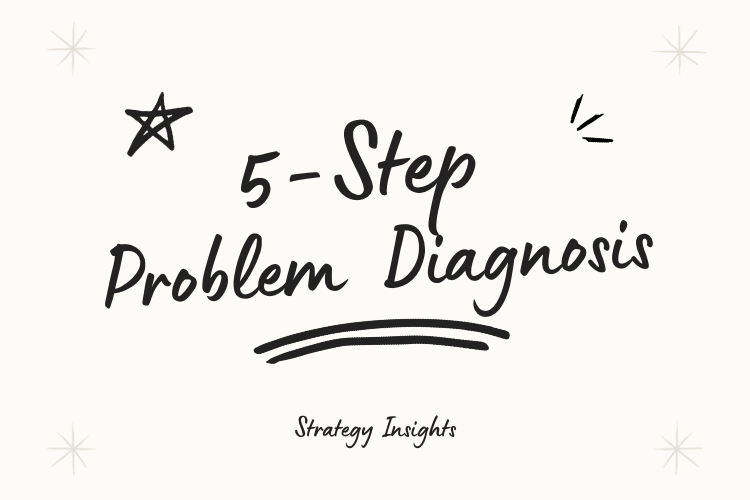In Search of the Hidden Problem: The Five-Step Path to Diagnosis

In the realm of problem-solving, we often find ourselves adrift in an ocean of confusion, frantically searching for the lighthouse that guides us to an answer. We crave a system, a method, a formula that brings clarity, understanding, and resolution. Such a formula does exist, and it comes in five distinct stages: Question, Imagine, Explore, Challenge, and Experiment.
1. Question: The Immediate Problem and Its Importance
In our first step, we begin as any good detective would—with a question. However, our question isn’t merely to identify if there’s a problem. No, our question probes deeper: Is it an immediate problem? Why is it important to solve? This stage isn’t merely about realizing there’s a fire; it’s about understanding why the fire matters.
In 1962, when John F. Kennedy declared we’d put a man on the moon within the decade, he wasn’t reacting to an immediate problem. He was responding to an important one. The “moon problem” was a potent symbol of technological and ideological prowess, a race we felt compelled to win. The key here is not just to recognize a problem but to understand its implications, its urgency, and its significance.
2. Imagine: The Future of the Problem
Next, we are to visualize the future. Imagine a year from now. The problem has gotten worse. What happened? This step is not about invoking fear but understanding consequences and potential trajectories.
Remember the financial crash of 2008? The seeds of that crisis were sown much earlier, yet the warnings went unheeded. By imagining the future, we can foresee the potential ramifications of our current problems and possibly avert catastrophe. It’s the way of the futurist, the visionary, the leader.
3. Explore: The Six Thinking Hats
Our third step calls for exploration, but not of the physical kind. We explore the problem using Edward de Bono’s “Six Thinking Hats” framework. Each “hat” represents a different thinking style: facts (white), emotions (red), discernment (black), optimism (yellow), creativity (green), and process (blue). It’s akin to viewing our problem through six unique lenses.
Suppose the problem is a controversial new policy in your company. The white hat might list all the facts about its implementation, the red would address the emotional response from the team, the black would critique potential flaws, the yellow would highlight the benefits, the green would suggest creative alternatives, and the blue would ensure a balanced process. This method allows us to grasp the full scope of a problem.
4. Challenge: The External Viewpoints
At this point, we’ve delved deep into our problem, but we must not become myopic. The fourth step, therefore, is to seek external viewpoints. Is this problem really that big or important? It’s akin to a reality check, a second opinion, a ‘sanity test.’
Consider the famous “blue dress or gold dress” debate that took over the internet. What was a major problem for some (how can you not see it’s blue?), was trivial for others. Sometimes, an external perspective reveals the magnitude (or lack thereof) of our problem, rescuing us from the quagmire of overthinking or underselling an issue.
5. Experiment: The Quick Test Solutions
Finally, we arrive at experimentation. Rather than seeking a perfect solution, we should develop and test multiple solutions quickly. This method, often used by technology companies, encourages iterative learning and avoids the pitfalls of a ‘one-shot’ solution.
Google, for example, constantly tests variations of their algorithms, products, and interfaces. They understand that the first solution might not be the best one. By experimenting, they gather valuable data and insights, refining their approach until they hit the sweet spot.
For your problem, consider creating a few quick, low-cost prototypes of potential solutions. Test them in a controlled environment, gather feedback, and refine your approach based on your learning. This is the realm of the tinkerer, the innovator, the relentless improver.
Diagnosing a problem is not about finding the quickest, easiest answer. It’s about understanding the issue in all its complexity, appreciating its potential impact, and crafting a solution that not only solves the problem now but ensures it stays solved in the future.
By following the five steps—Question, Imagine, Explore, Challenge, and Experiment—we equip ourselves with a comprehensive toolset to unravel even the most intricate problems. This formula takes us from confusion to clarity, from problem to solution, and from the unknown to the understood.
Ultimately, it’s about becoming better problem solvers because as we grow in our ability to diagnose and address problems, we also grow in our capacity to innovate, lead, and make a difference in our world. Remember, every great invention, every ground-breaking idea, and every leap forward starts with someone recognizing a problem and daring to solve it.
